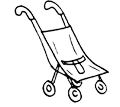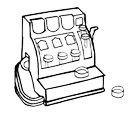How to communicate with baby using sign language?
"What? But my child isn't even deaf. Why teach him sign language? Does it really work?" When we discovered the idea, we asked the same questions. Spoiler: yes, it works! We tested it for you and tell you all about it.
A crying, screaming, grumpy or unwilling baby is often a source of stress, sadness, irritation, exasperation or even despair (depending on the amount of sleep) for parents (and neighbours).
To avoid torturing yourself for hours on end wondering what's wrong with your baby, (s)he's sick, broken, crazy ... (given the amplitude of sound that emanates from these little bodies, at some point it's normal to consider everything), we initiate the family to communication via sign language. It's a fun and effective way of communicating with babies about their needs and desires, even before they can speak.
First times are always exciting: the first look, the first smile, the first handshake. Now we can add to that list: the first time he'll be able to sign. Thanks to his ability to imitate, and motor skills that refine month by month, a baby under a year old is perfectly capable of expressing his needs, desires and emotions (often his tantrums, in fact) even before he can pronounce his first word. Amazing! Yes, but it's not all that surprising when you consider the speed at which these little creatures evolve during their first year of life. In fact, this new way of communicating with baby is so practical that it is now used in some crèches, nurseries and pre-schools in Belgium and elsewhere in Europe.
How to learn sign language?
By simply learning to sign yourself. Get a book or subscribe to various accounts dedicated to this topic on social networks(Instagram and Youtube mainly). Just type the keywords: baby sign language into the search engines and you'll come across a wealth of content, some of it free.
Personally, we've been offered the book by Marie Cao, bilingual sign language professional, mother of two daughters and author of Le Grand Guide des signes avec Bébé. Very active on Instagram via her account @littlebunbao, she spreads her knowledge to her followers on a daily basis through little lessons. We're fascinated by the videos she shares showing little ones just a few months old clamoring for their bottle or expressing their refusal to get out of the bath. So we thought we'd give it a try with our daughter Lily.
All you need to know about communicating with your baby using sign language
The most important
Don't be afraid of ridicule. By no means because sign language is a subject of mockery. But you have to admit that when you find yourself face-to-face with your baby, signing with gusto, gesturing, repeating words and mimics to accentuate understanding, and in response you get a frown or a burst of laughter ... it can be a bit lonely. We have to admit that often it feels like he's just pulling your leg.
To teach a baby sign language, you need to be patient, you need to repeat it over and over again, but after all, it's only an appetizer for the years to come. If only we could get 1 euro for every time we say: "Be careful, don't put your fingers in the socket, tidy your room, etc.".
When should you start llearning sign language?
Whenever you want. From birth if possible, otherwise the sooner the better. All children are able to sign, but not all do so at the same time.
We started with Lily from the age of 6 months, which is exactly the age when l's brain becomes capable of retaining the signs it sees, without being able to reproduce them because it lacks the necessary fine motor skills. Some children reproduce signs before they can walk, others after this crucial stage, which requires a great deal of energy and concentration. Some even do it after acquiring their first words, and only use them to express emotions, for example, which are complex concepts to verbalize (we're thinking it could be useful with some adults too ...). It's never too late to start.
The most important thing is to respect l's rhythm, without any pressure, to persevere and not to get upset. We try to associate communication with something positive and joyful.
"At twelve months, Lily wasn't signing (she was just learning to walk), but she clearly understood some of the words she heard and signs she saw. When she cries because she's hungry and the word "bibi" is pronounced in accompanied by the sign "eat", she stops crying, understanding that it's going to happen. She often claps her hands or lets out a cheer or a burst of laughter to show her satisfaction at having been understood. Once she's learned to walk, Lily starts signing. She's able to tell us: again, sleep, bath, wash. We're really impressed. Marie-Noëlle, Milk Away MUM.
How many signs to teach him?
There are no rules, just do as you please, according to your time, your desires and l's usefulness. From primary needs (eating, drinking, changing, dressing, feeling pain, fear, wanting more, saying stop) to whole rhymes mixing animals, verbs and emotions. And we guarantee that these little stomachs on legs quickly assimilate the signs associated with food...
What are the advantages of communication via sign language?
There are many of them, and we're surprised that the practice isn't more widespread. Learningsign language at l will first and foremostopen up the minds of adults and children alike. It's a way of discovering another culture and community, and of raising awareness of the handicap of deafness.
A word of clarification: signs learned from a book or an Insta story are not enough to become bilingual in sign language. To achieve this, you need to learn by immersion alongside deaf people and through specialised associations.
Another advantage is that you create a very strong bond with your baby. A bond of trust sis established because we are finally able to understand each other clearly. Lhe use of sign language helps to reduce all kinds of crises, crying and stressful moments.
It also allows for early bonding between siblings and other family members.
Finally, and contrary to popular belief, a child who knows how to express himself using sign language is not going to speak later than another. On the contrary, having acquired a taste for communicating, they'll want to go further, faster. What's more, when we sign, we accompany the gesture with the word it signifies, so the baby's brain makes links between what it sees and what it hears, which helps it to understand and retain what it learns.
"Personally, we're convinced of the principle and reassured at l'idea to know that Lily now has another, faster way, adapted to her abilities, to tell us what she wants and doesn't want (even if the nods to say no are perfectly mastered). We realize that she already understands many words without being able to pronounce them. Our only fear now is that we won't be able to pretend we don't understand when she insists on having more ice cream... ". Marie-Noëlle, Milk Away MUM.
#milkawayapparel #inmumwetrust #baby #babytalk #signlanguage #babysign #babysignlanguage #family





